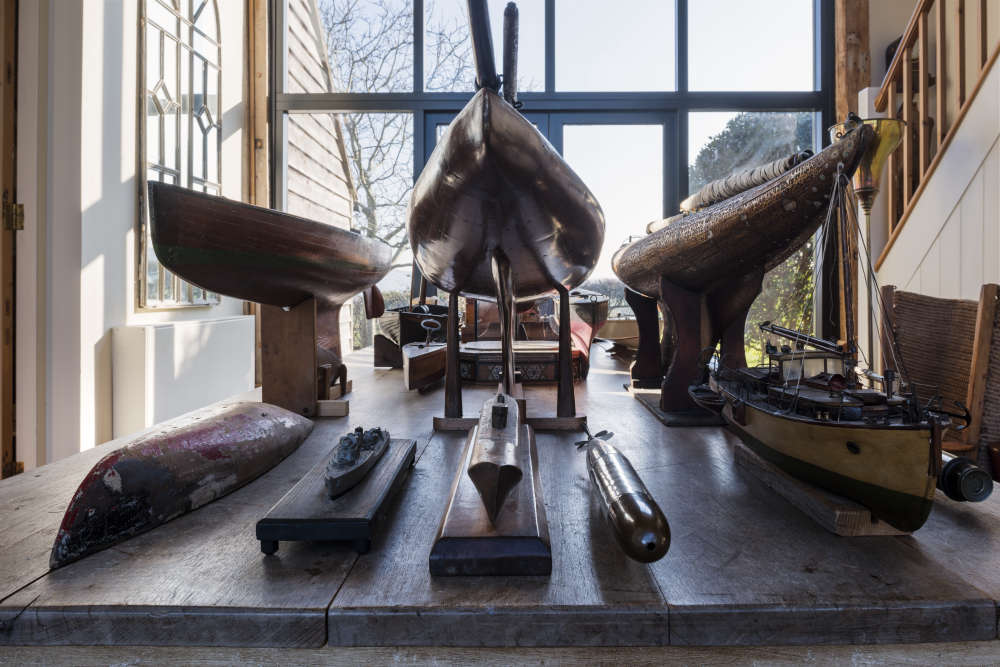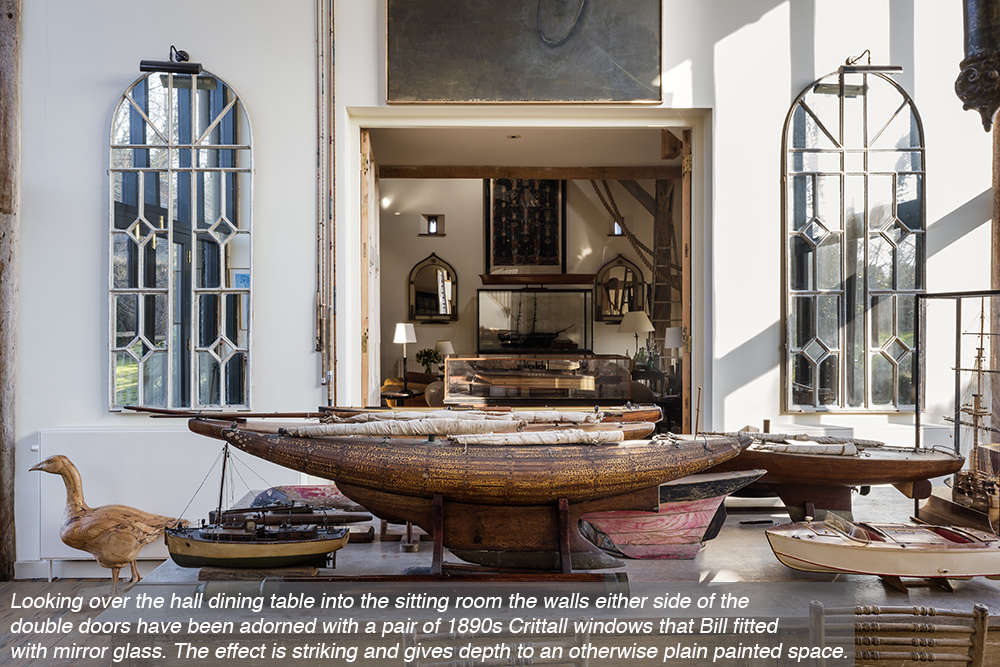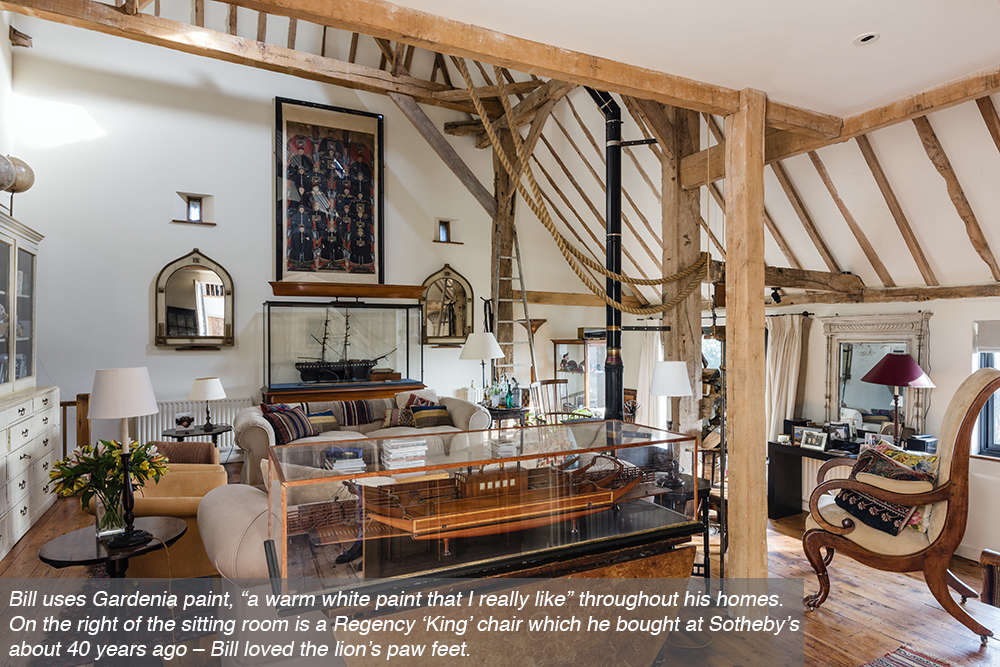
A Sussex barn is restored and converted by a man who knows how to work with history and just how to display his striking collections
The most striking thing about Bill Broadbent’s late 18th century Sussex barn is that it looks like a barn. Not for him the inappropriate domestic windows and suburban desecrations of many barn converters up and down the country.
Bill, a property developer specialising in historic buildings and hotels has spent his life living in ancient buildings; in fact he was born in the famous Thames-side pub, the 15th century Prospect of Whitby. Bill grew up surrounded by an awareness of architecture and antiques especially encouraged by his grandfather who particularly loved clocks and lived in a fine old house on Kingston Hill.
“I bought the barn for a weekend home, with outline planning permission, a dodgy cement tile roof, dirt floors and a collapsing shed where the kitchen now is,” said Bill. Needless to say an awful lot of work was done to give the appearance that the imposing flint, brick and oak structure had survived wholly intact. The roof was replaced, a massive concrete slab was poured as underpinning to steady the barn, beams were repaired or carefully replaced and the giant timber entrance doors which were beyond repair were copied exactly to form shutters to the glazed cart entrance.

One step into the impressive hall and it is apparent that the interior has been treated to the same exacting standards as the exterior. “I decided not to employ an architect and to sketch up my own vision of how the space would best work retaining as much of the grand scale of the barn as possible while not scrimping on essential cosy bedroom accommodation – there are four bedrooms and three bathrooms all accessed off the right side of the hall,” he said. The rooms range from cottagey to monumental with a practical, painted wood kitchen created in a former storeroom.
Naturally Bill took the time and trouble to obtain as many reclaimed materials as he needed to give the barn a credible authenticity. He found plenty of Georgian pine floorboards from a demolition in Brighton, reclaimed former brewery roof tiles and he lay 20,000, 400 year-old cobbles from the lane entrance to the front door. The likely daunting task of filling the house with interesting furniture and objects was surprisingly easy as the barn was the perfect place to house Bill’s striking mix of fascinating things.
Having been a collector since his early teens and after downsizing his London home Bill had a wonderful choice spanning lovely former museum cabinets, 19th and 20th century model yachts and boat hulls (some of which are known to have been raced in their heyday), Georgian glasses and decanters, masses of scientific instruments of all sorts from telescopes to steam engine pressure gauges, primitive stick chairs (“a bit of a passion of mine”), rugs, pictures, textiles, fishing rods, a remarkably life-like stuffed owl, even a gun powder bucket. The list goes on and every piece has an interesting or entertaining back story. Bill has bought things for over forty years at country and city auctions, whilst travelling – “I found that pair of Sumak rugs in Ukraine” and dealers who know his particular interests of old come to him when they find something he would find irresistible.

It is not only the living spaces which are treated as a home museum, the bedrooms are furnished with equally intriguing and diverse antiques as well. Find a giant German armoire and velvet chaise longue in one room and old lamps, prints and carved figures in others. The only trouble with having a passion for collecting is that although there are plenty of tables there is nowhere to eat as they are piled with fascinating 'toys'.
The fact that the building is unusually light is down to some very clever design. Not only by filling both sides of the original central gap of the cart entrance with glass but the space above the small sitting room ‘study’ gallery, which overlooks the hall, has been filled with glass too. There is a roof-light and the original windslips that allowed the east/west air flow to dry hay have been glazed. The kitchen, which faces the entrance driveway is lit by windows and glass doors along its length, while the master bedroom is dual-aspect providing wonderful rural views.
The more one looks at this special country home the more one notices Bill’s connoisseur eye for detail. The ironwork on the ‘braced’ plank doors is copied from an old pattern, the locks have leather latches, the thick hanging ropes, intended to be used as an exercise aid look exactly right amongst the old ships beams used in the construction. The beautifully crafted wooden frame of a canoe floating high in the hall roof space is another example of Bill’s ability to allow form and craftsmanship to be seen as art. “I love this house,” Bill explained, “it’s the perfect place for the things I like to live with.”

Words: Johanna Thornycroft/Living4media
Photographs: Andreas von Einsiedel/Living4media

 Blooming Times: Happy Faces
Blooming Times: Happy Faces
 Blooming Times: Winter Sparklers
Blooming Times: Winter Sparklers
 Homes Extra: Restore, Repair, Recycle
Homes Extra: Restore, Repair, Recycle
 Home Style: A Scandi Winter's Tale
Home Style: A Scandi Winter's Tale
 Blooming Times: Winter Wonders
Blooming Times: Winter Wonders
 Home Style: Bold, Brave & Beautiful
Home Style: Bold, Brave & Beautiful
 Blooming Times: The Answer Lies in the Soil
Blooming Times: The Answer Lies in the Soil
 Blooming Times: Heavenly Hyacinths
Blooming Times: Heavenly Hyacinths
 Legendary Builds with Phoenix Construction Services
Legendary Builds with Phoenix Construction Services
 Blooming Times: Know Your Enemy
Blooming Times: Know Your Enemy
 Bespoke Dreams from Eridge Green Kitchens
Bespoke Dreams from Eridge Green Kitchens
 10 Hot Years: iFit Fires & Flues
10 Hot Years: iFit Fires & Flues
 Home Style: Bold Type
Home Style: Bold Type
 Blooming Times: The Sky's the Limit
Blooming Times: The Sky's the Limit
 Home Style: A Better Way of Life
Home Style: A Better Way of Life
 Homes Extra: Shed Space
Homes Extra: Shed Space
 Blooming Times: Top of the Pots
Blooming Times: Top of the Pots
 Kids Zone: Get the Kids Growing
Kids Zone: Get the Kids Growing
 Home Style: Pastures New
Home Style: Pastures New
 Homes Extra: Let There Be Light
Homes Extra: Let There Be Light